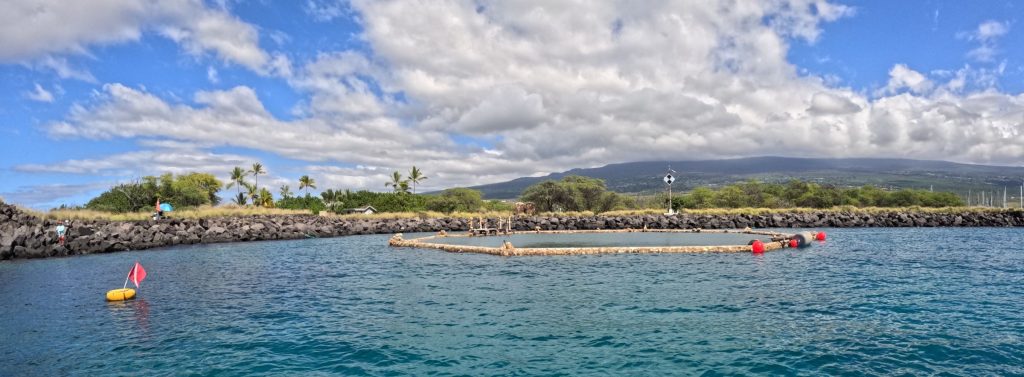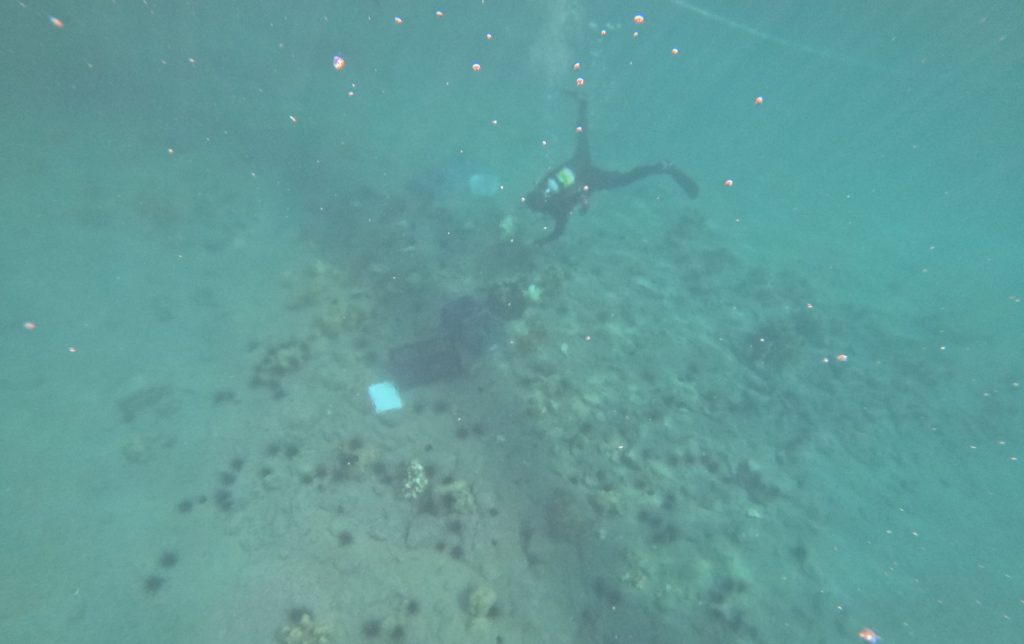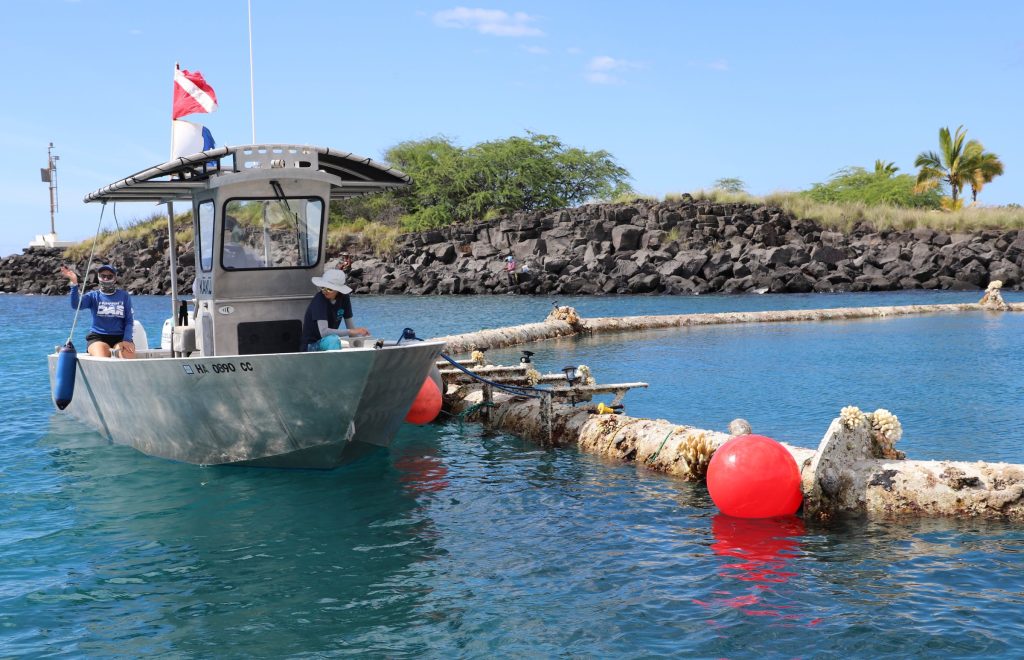‘Massive effort’: Hundreds of coral colonies recovered from Honokōhau harbor for restoration
A collaboration of conservation organizations, agencies and institutions, including the Hawai‘i Department of Land and Natural Resources Division of Aquatic Resources, completed what one scientist involved called a “massive effort” that made a “monumental impact” on coral reef restoration in waters off the Kona Coast of the Big Island.

Divers from the Division of Aquatic Resources, The Nature Conservancy and Arizona State University last week successfully removed and relocated nearly 11 years worth of coral growth from a decommissioned offshore fish farm pipe ring that was towed last week from near the busy Honokōhau Small Boat Harbor in Kona.
They then teamed up to remove hundreds of large, healthy, native coral heads from the ring, which supported the teepee-like structure formerly used to raise Hawaiian Kanpachi, a yellowtail greater amberjack.
“Essentially, this pen has been in the water for 11 years, since 2013, and in that time, just natural recruitment of coral has happened to the point that now it’s time to take the pen out of the water,” explained Julia Rose, coral restoration program manager for The Nature Conservancy. “And there’s a whole, you know, 11 years worth of coral on the pen.”
The partners worked closely through the past couple of years to build capacity for coral restoration and emergency response.
“Opportunities like this are actually really valuable because the amount of time and effort and money that it would take to grow 11 years worth of coral that’s on these offshore pens is huge,” added Rose. “Any amount of coral that we can save from these pens today is so valuable. It’s the biggest bang for the buck that you can get.”
The coral removal was a complex and well-orchestrated 3-day operation.
Corals on top of the pipe were not recovered; prolonged air exposure kills them. But most everything below the water line was removed using chisels and hammers.

Those corals sank to the bottom of the harbor, where divers collected them in milk crates that were then lifted onto boats. Large coral heads were gingerly placed into water-filled coolers while smaller ones were bubble-wrapped and placed in other coolers.
“These structures are fantastic areas for these corals to settle on,” said Zachary Craig, Division of Aquatic Resources coral restoration coordinator on Hawai‘i Island. “Great in the short run, but in the long run, they need a proper reef home to survive. This is one of the largest mature colony collections that I’ve ever heard of on Hawai‘i Island.”
The larger corals were taken by boat back to the reef, in-shore of the four remaining operational fish pens near the decommissioned ring. Full crates of corals were lowered to the ocean floor by divers and released.
The fish pens, including the decommissioned ring, are located within an aquaculture production area of Blue Ocean Mariculture.
Those larger corals will be affixed to existing reef structure this week using a special marine epoxy.
The smaller, wrapped corals were taken to a new coral nursery at the National Energy Laboratory of Hawai‘i, about 8 miles northwest up the coast from the harbor.
The ʻĀkoʻakoʻa Coral Restoration Nursery opened in May. It is the first large, land-based coral nursery on Hawai‘i Island, spanning 120 miles along the Kona Coast with 72 seawater-filled “raceways” where corals are placed, and is home to 35-plus coral species.
It is also thought to be the biggest nursery of its kind in the entire Pacific.
“In the nursery, we can give them a kind of an intensive care unit … and know that we’re giving them the absolute best conditions,” said Arizona State University restoration scientist Grace Klinges. “We can also use that nursery to do other types of research to address the causes of coral stress.”
The dive teams collected hundreds of healthy colonies as part of the recovery effort.
“It’s great to be responding to something in a positive way where, you know, these corals would die otherwise. We think that we can save a fair number of them by working together,” said Klinges. “This is such a massive effort. I don’t think we even knew how big it was going to be until we got in the water and saw it. But I think we’ve made a monumental impact.”
She added that the coral moved to the nursery so far are doing well, and the team hopes they continue to thrive there.
Blue Ocean Mariculture Chief Executive Officer Dick Jones said his company is committed to the health and resilience of Hawaiʻi’s marine ecosystems and honored to partner with the the state and its partners for the coral reef restoration initiative.
“By providing reef samples from our net pens off the Kona Coast, we can help support the regeneration of vital species in our coral reefs, reinforcing both environmental sustainability and the balance of Hawaiʻi’s coastal waters,” said Jones. “This collaboration is a natural extension of our team’s dedication to Hawaiʻi’s ocean ecosystems and to preserving their vitality for future generations.”
Blue Ocean Mariculture’s offshore team is in the open ocean every day off the Kona Coast, witnessing firsthand how marine life such as coral and other reef organisms naturally establish on the company’s net pens.
“Being able to share these samples for Hawaiʻi’s reef restoration efforts is something we’re proud of, as it contributes directly to the work in regenerating healthy reef ecosystems,” said Blue Ocean Mariculture Vice President of Marine Operations Tyler Korte.
Sponsored Content
Comments


















